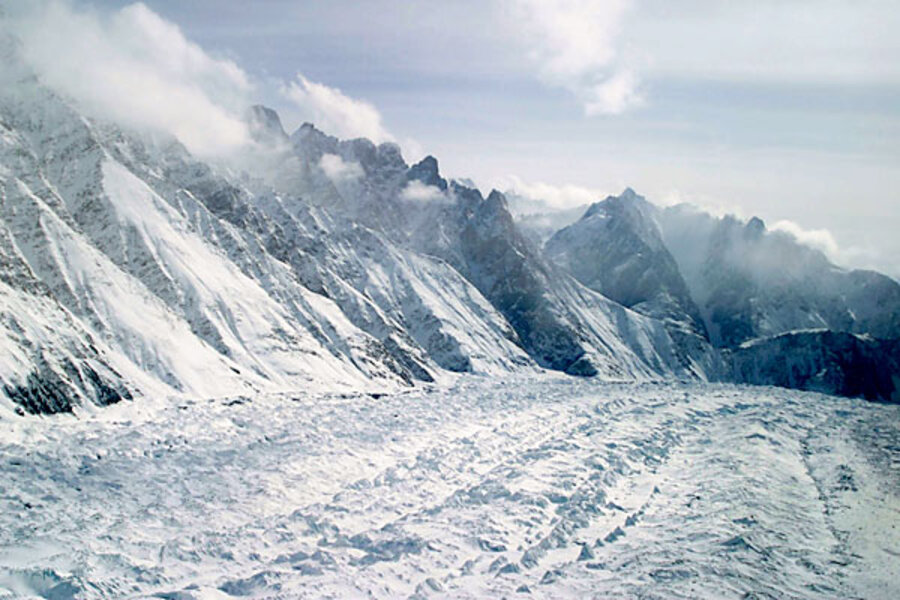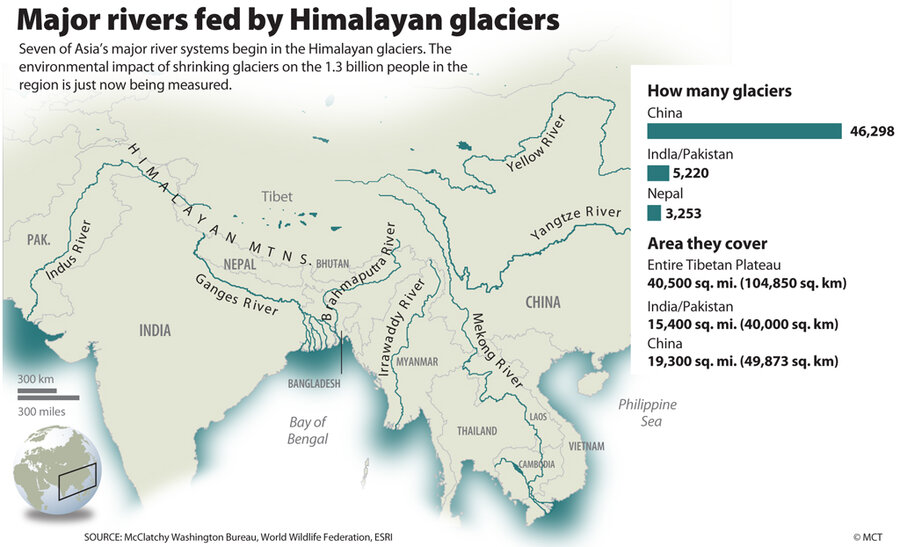Himalayan glaciers gone by 2035? IPCC mistaken.
Loading...
| New Delhi
First, the good news: Himalayan glaciers are not likely to disappear by 2035, as originally claimed by a widely-publicized United Nations report.
The bad news? Scientists did not challenge the spurious date for years and some now warn that, in fact, our understanding about Himalayan glaciers rests on thin data.
Over the past week, it emerged that the doomsday date found its way into a 2007 report from the Intergovernmental Panel on Climate Change (IPCC) not from a peer-reviewed study but from an interview published in the New Scientist 10 years ago. That article attributed the prediction to Syed Iqbal Hasnain, a noted Indian glaciologist, who denies he put forth such a date.
Dr. Hasnain said this week he saw the mistake 10 years ago but did not seek a correction because it did not appear in a scientific journal. Other Indian scientists, after debunking a similar claim about melting glaciers in response to an Indian Parliament inquiry, also did not seek out the press with the information, says Rajinder Ganjoo, director of the Institute of Himalayan Glaciology at the University of Jammu.
"Perhaps we thought it was not important at the moment or maybe that the IPCC was a big dinosaur," he says. Asked if he has felt political pressure, he declined to comment further.
The IPCC draws upon some 2,500 scientific reviewers and basks in the prestige of a Nobel Prize, while Indian glaciologists number barely more than a dozen. And the task ahead of them is, well, Himalayan.
"As of today, there are roughly 50 glaciers that have been worked scientifically," says Dr. Ganjoo. "Frankly speaking, 50 glaciers are absolutely a tip of the iceberg to get an idea about the other 9,500 [Himalayan] glaciers. I think it will take us ages to do work on each and every glacier."
Hurdles abound. Many glaciers lie above 18,000 feet, making them virtually inaccessible. The mountain range also falls along tense international borders between India, Pakistan, and China. India has classified decades of glacial data gathered by the Geological Survey of India. Ganjoo's work on the Siachen glacier – where Indian and Pakistani troops periodically trade potshots – required special permissions from defense officials.
A consensus has emerged among scientists that the data gathered so far generally shows glaciers on the retreat particularly in the northeastern Himalaya. But there remains debate over why they're shrinking, and at what rate.
Some of that debate has been hashed out in the scientific journals. Ganjoo sides with a faction that argues there are so many factors involved in glacial melt that a finger cannot yet be pointed at rises in atmospheric temperature – i.e. global warming. He published a paper in August presenting evidence that the famed Siachen glacier has shown "hardly any" retreat. In a phone interview, he calls the melt rate "insignificant."
He says the melt rate fluctuates too much between glaciers - and year to year – to make any prediction about when (or if) Himalayan glaciers will disappear. The IPCC apologized, and said it will remove the 2035 date from its report.
Hasnain, meanwhile, remains a leader of the other faction that sees strong evidence for global warming's dramatic impact on the glaciers.
"With reference to climate change and its impacts on Himalayan glaciers, can there be any doubt on the pathetic state of the Himalayan glaciers!" writes Hasnain, in a press release this week.
Hasnain notes glacier melt is born out by "satellite images consistently assessing even the remotest zones over a period of time" to counter such arguments about few glaciers visited.
Yet he doesn't dispute other local factors play some role: "Micro-level climactic as well as topographic variations "have strong influence on local level impacts of global warming."
Such important nuances of the debate, however, are often lost on the public.
"People are not reading the details and they are only looking at the executive summaries and commenting," says Chandra Bhushan, associate director of the Centre for Science and Environment in New Delhi.
But he also worries that those trumpeting the IPCC mistake are also jumping to false conclusions. "The glacier debate is playing into the hands of the polluters – by rubbishing the IPCC report, which I think it correct to question. But to say that climate change is not happening because someone wrote 2035 in chapter 10 is taking it too far."
Politics may play a role also in what is not said.
"There's not many scientists who have come into the debate, it's only politicians and environmentalists," says Darryl D. Monte, chairperson of the Forum of Environmental Journalists of India. "There are all kinds of injunctions from their superiors not to speak out to the media."
The Indian government has started to respond to the international pressure to both produce and disseminate more information about the Himalayan glaciers. The Ministry of Environment and Forests commissioned a survey of the scientific literature on the topic that was released in November. The report acknowledges that India has not put enough money into glacial research and announced the future creation of a new research institute.
[Editor's note: The original headline was corrected because it sourced the 2035 melt date to an Indian scientist, who denies he ever made the statement.]






